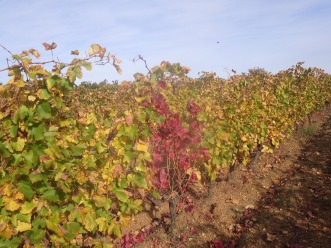Soutirage? It’s where you take wine from one container and move it to another. Traditionally this was done from barrel to barrel by gravity but these days it applies to moving the wine by other methods too. Why? Well the wine has been fermenting on lees, the dead yeast cells and other parts of the grapes. The wine needs to be removed from these as they cause cloudiness and you don’t want to drink wine full of lees. The lees can also cause off flavours in the wine so once they have served their purpose in helping to ferment and flavour the wine in a positive way they need to be separated.
By moving the wine you also add oxygen to it and remove the risk of carbon dioxide building too much in the cuve which might cause issues such as reduction, a wine fault leading to odours of rotten eggs, rubber, struck matches or worse. That oxygen acts as a kind of inoculation too, a little bit helps to reduce the risk of wine oxidising later.
Therefore, on Friday 30th October, Jeff decided to carry out soutirage. Also, as the weather has been very warm they will continue to ferment a little longer in their new home before the colder weather does arrive. This means that there will still be some CO2 in the wine. Too much is bad but a little is good and this is the core of winemaking – finding the balance between all these different pros and cons. CO2 in small quantities helps to stabilise a wine and makes not using SO2 easier (important at Mas Coutelou) and also adds a little freshness and sense of texture, possibly a sense of acidity too. Oxygen, carbon dioxide, lees – you want to get just the right amount but no more.
What this did mean was more planning and more of the puzzles of what wine goes where. My last post showed how complex this is. And here we bring in the surchargé part of the title. Jeff has had a busy week with lots of paperwork, orders to sort, bottles to label, package and get ready for sending out to cavistes around the world. Add in administration work for customs, taxes and many other agencies. The side of being a winemaker that people don’t really see.
I went to the vineyards on Thursday to take some photos of the beautiful colours in the vine leaves, unexpectedly I found Jeff in Peilhan digging out cannes de provence near a stream with a pick. He said this was his break from the paperwork, he needed some fresh air.
Looked like more hard work to me, and people ask me if I would not want to become a vigneron!
Please note that I have updated the Out And About and Tastings pages recently, click the links at the top of the page to see what’s been happening.











November 2, 2015 at 5:03 pm
Did I miss something…or what are “Cannes de Provence”? Stones?
I’m hoping that with the wine (sic) we are making there will be a little CO2 left when bottled, in order to give a very low alcohol wine a bit of a lift. But I have no way to judge whether there will indeed be a prickle. I’m reasonably confident it won’t have enough yeast to keep it fermenting, though we have no filter, and no desire to filter it.
LikeLiked by 1 person
November 2, 2015 at 5:22 pm
Cannes De Provence are a bamboo like plant which grows very tall where there is water. They are seen as a bad sign in the vineyard, certainly Jeff has spent a lot of time over the last years in removing any of them which appear.
I’d say that a little CO2 would be a very good thing in the circumstances. Did you keep some lees to add later to get fermentation kick started if necessary?
LikeLike